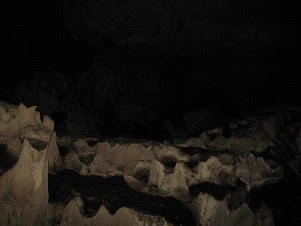












 The Wind Cave is a very popular local tourist destination close to Kuching. It probably received its name from the draught of air which passes through the passage leading to the Sungai Sarawak Kanan on which it is situated. The name is translated as "Wind Cave" or "Cave of the Winds".
The Wind Cave is a very popular local tourist destination close to Kuching. It probably received its name from the draught of air which passes through the passage leading to the Sungai Sarawak Kanan on which it is situated. The name is translated as "Wind Cave" or "Cave of the Winds".In fine weather, many groups from Bau and Kuching visit the cave. The most popular attraction is the western entrance of the cave which has a small beach adjacent to the Sarawak River. It is a favourite picnic and swimming spot that has gained in popularity after the closure of the Bau Lake for the mining of gold.
While some visitors take to swimming and relaxation in or near the river, others would explore the cave. Torches are needed to enter the cave and explore its passages. The stream provides easy access through the cave to the river. This cave is smaller than the Fairy Cave, but it has different formations and the cave stream adds a different focal point.
The Wind Cave is located in the limestone area of Bau to the southwest of Kuching. It is about 5 km southwest of Bau. The cave is situated off the Bidi road which passes the Bau Lake. A new sealed road has recently been completed to the cave and the Sarawak River. A parking bay is situated adjacent to the river at the end of the access road from Kuching. Buses are available to Bau.
The Sarawak River divides into two branches about 60 km from the river mouth. Its right arm, the Sungai Sarawak Kanan, flows past the western entrance of the Wind Cave. The cave's dominant feature is the small stream which meanders through the cave to join the Sarawak River. This stream has cut a narrow meandering path in the cave floor and has also cut current scallops on the walls. The main cave passages are wide with flat roofs, while the smaller passages form an irregular network in the northern section of the cave.
The major features of the cave include the stalagmites and stalactites, and pillars which form when these two join together. These are all common calcite formations. The minor features include floor cavities, pendants and current scallops. The limestone of the cave is pale grey or blue in colour and is fine-grained. Deposits of clay as well as thin layers of guano or rock phosphate are found throughout the cave.
The floor of the main passage has conical cavities which are separated by blade-like pinnacles of limestone. Stream erosion is evident by the smooth horizontal grooves in the floor and scalloped walls of the passages. These current scallops have a honeycomb appearance and indicate the direction of the flow of water. Another formation are the pendants which are limestone projections approximately 60 cm in length and which hang from the roof of the cave passage.
The major features of the cave include the stalagmites and stalactites, and pillars which form when these two join together. These are all common calcite formations. The minor features include floor cavities, pendants and current scallops. The limestone of the cave is pale grey or blue in colour and is fine-grained. Deposits of clay as well as thin layers of guano or rock phosphate are found throughout the cave.
The floor of the main passage has conical cavities which are separated by blade-like pinnacles of limestone. Stream erosion is evident by the smooth horizontal grooves in the floor and scalloped walls of the passages. These current scallops have a honeycomb appearance and indicate the direction of the flow of water. Another formation are the pendants which are limestone projections approximately 60 cm in length and which hang from the roof of the cave passage.


0 comments:
Post a Comment